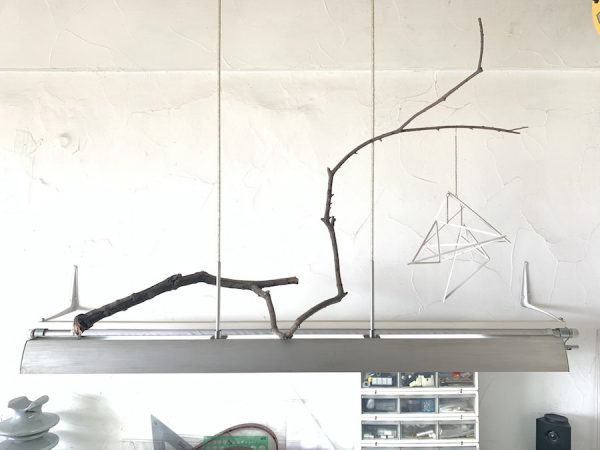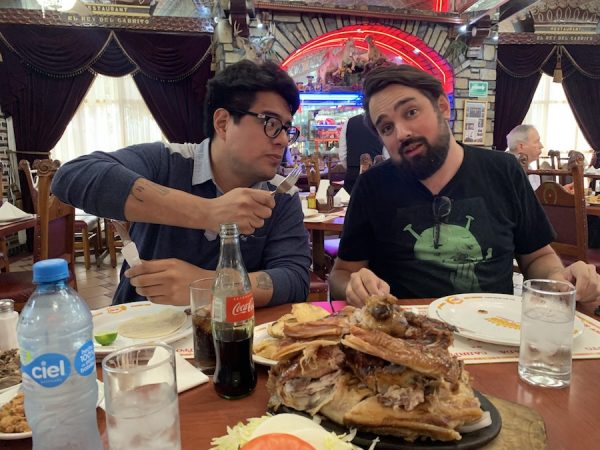The following is Part Two in a series of three art-travel essays by the author. Find Part One here.
Para leer este artículo en español, por favor vaya aquí. To read this article in Spanish, please go here.
Almost immediately everything was more difficult in Monterrey. It was palpable that we had arrived in a very, very different place from the one that we had been in. We had moved through Guadalajara with the help of a well-developed visual arts community, and by contrast the city of Monterrey felt ungraspable.
We walked out of the airport that night into oppressive humid heat. The sprawl of the city glittered in the basin below and across the mountains surrounding the city itself, and we took in the scenery during the near-40-minute drive through a complicated yet pristine highway system. The trip to Monterrey was going to be a quick one — only a day and a half — but we had the best guide in Ernesto Walker, a former resident of Monterrey and new fixture in the Austin arts scene.
That night we focused on settling in and getting some rest in preparation for the day to come, a great plan stunted by malfunctioning air-conditioning units in our Airbnb. That first night was a hot and restless one for all of us.
* * * *
Ernesto picked us up at 10 a.m. the next morning. We piled into his car, excited to start our day in the San Pedro municipality of the city, which is also arguably the wealthiest neighborhood in the entire country. Compared to most cities in Mexico, Monterrey is unique in its identity of ostentatious wealth coupled with decades of violence. Its contemporary art scene has suffered boom-and-bust cycles that have stifled its development. We were eager to get started on understanding it.
We had a long day planned, and visits to spaces so varied that we felt like we were falling through the metaphorical holes of a community that everyone said exists, but that we couldn’t understand. Our first appointment was at La Cresta, a commercial gallery with an ambitions program run by an equally ambitious young curator named Abril. We arrived more than 20 minutes late after our police encounter, and wandered around, then up and down elevators trying to get our bearings in the massive, shiny new shopping complex that was mostly empty, and home to La Cresta.
We felt lost; there was a sense of disorientation that stood between us and understanding the city, both geographically and culturally. Abril shared stories of the community, of a newer generation of artists who are acquiring spaces from their families and using them as project spaces. But she was the first of many to tell us that these spaces and projects all exist much further outside of the city, in areas that are not concentrated in one particular neighborhood or center. She assured us it was an exciting time to be in Monterrey — a sentiment shared by everyone we were to meet on this leg — but it was a feeling we couldn’t access and never really witnessed.
We stayed in San Pedro that day. After talking with Abril at La Cresta we made our way to an older section of the municipality, one that felt like a small town you might see in Chiapas or Oaxaca, tucked far up into the mountains where a chilly fog of altitude lingers just above the trees. We visited Leun’un, a gallery and workshop run by a duo who also offer art classes. Theirs is a model where the white-cube gallery concept is sustained and supported by workshops and classes, including those for ceramics, drawing and painting. Their method is to find entry points for curious minds with classes, then expose that curiosity to contemporary art via the white-cube space with its curated exhibitions. They had found a model that worked for them; their program has been in existence for nearly a decade, and has survived multiple moves (a side effect of the region’s rising rents and costly real estate).
We walked a few blocks to the hidden and stunning white cube of fifi projects, where we said hello to dear friend and director Eduardo Lopez. We were all blown away by a pristine exhibition of new work by Brian Eno in the equally pristine space. Eduardo walked us through the conference room and showroom and relayed his plans for the gallery both in and outside of Monterrey. He talked to us about the conservative collector culture of the city — an issue that was still opaque to us, but one that seems similar to that of our own city of Austin.
Monterrey has only one major visual arts institution, MARCO Museo, located in the downtown city center. A majority of wealthy people give money to support MARCO, but rarely purchase art by living artists. Instead, their collecting is reflective of the culture of industry long established in Monterrey. Alongside its wealth, Monterrey has long been an industrial city. It is surrounded by factories, and here everything feels like a means to a financial end. Purchasing classical still-life paintings makes more sense to the Monterrey collector than taking the risk to invest in a young artist’s career. Eduardo has long led the charge of conceptual, experimental work in the commercial sector of the arts here, and has successfully tapped into a collector market where he is trusted, but he assured us that it was not without risks, sacrifices, and the investment of significant time in relationship building.
Our last stop of the day was to catch up on what Ernesto had been producing since we had last seen him. We also planned to meet for tacos and drinks, to talk in a more informal setting. We walked into Ernesto’s home and studio and were struck by his view that overlooked the city. He was tucked up on the side of one of the mountains, and his balcony offered an impeccable view of the city below. As we all pulled our phones out to capture the moment Ernesto explained that mountain range actually encompasses the city, and that day the mountains were hidden behind a thick layer of smog covering more mountains in the distance like a heavy blanket.
Ernesto talked with us about his most recent projects, about winning a prestigious federal grant, and about even more ambitious works he had in mind. The four of us sat in his living room and as the tone of the studio visit shifted into an afternoon cocktail we began talking about the city itself. We had started to get a sense of disconnect in the Monterrey arts community. Somehow artist weren’t talking to gallerists, or gallerists weren’t visiting new artist-run spaces, or a strange lack of “trickle down” in wealth and access was causing micro-communities to form without those communities talking to each other. Again, the scene felt like it was falling between our fingers.
This sentiment was reinforced when Ernesto, Eduardo, Wimpy, Zac and I all sat down later to catch up and discuss the day. Through our conversations it was becoming clear that the larger decentralization of the contemporary art world of Mexico City was necessary in Mexico — that artists need to either stay and invest in their own communities, or leave and then come back to build community based on what they learned elsewhere. That evening I sat between five men, informally moderating questions and responses as the conversation veered toward the idea of responsibility and communication between stratas in an art community: artists are responsible for inviting gallerists to their exhibitions; gallerists have a responsibility to show up; collectors have a responsibility to support living artists; etc. But what was striking was that the conversation kept returning to the issue of real estate — a subject Austinites are quite familiar with. Monterrey has space; it is filled with buildings that sit empty until new use is found for them, or they’re torn down for developers to cash in on tax benefits. Renting a building in transition would allow artists the shared studio complex model seen in cities like Guadalajara, and would connect communities. But Monterrey’s inaccessible real estate market — even empty real estate — makes this goal nearly impossible.
It seems that a repeating cycle of increased inaccessibility with a constant and visible excess of space contributes to Monterrey’s boom-and-bust arts identity.
We called it a night after a very long day and returned to our Airbnb. The air conditioner was still broken.
* * * *
We had all slept better our second night in the city. A cool breeze had rolled in that night and made our sleep much more comfortable than the night before.
We had a flight out to Mexico City that evening. This would be the last day of travel for me and Wimpy. This would be a day full of Monterrey studio visits, of looking at the artists’ perspectives of the scene, and building friendships beyond institutional partnerships. We hoped that the day would bring a little more clarity, and we piled into Ernesto’s car once again and headed to visit Tahanny Lee Betancourt in her home studio.
Tahanny gives her audience much more than she expects to receive in return, and once again (as in Guadalajara) we were met with a studio visit situation in which the objects were not necessarily the focal point of the work, but rather part of the conceptual practice of the artist. Tahanny spoke to us of grief, its process, and the abstraction of time through it. She took us through histories of her family, and her identity, and we were all left stunned by an experience of listening to an artist speak so eloquently about incredibly personal and difficult work.
We visited Ruth Aragon, a very young artists who’s shyness was as striking as her smarts. She handed us all Shiner beers as we walked in, and she talked to us about her transition into the contemporary art world from design. She had been moving toward painting, but working with a very specific and fragile paper to create illusions of texture and depth. At the same time she hadn’t stepped too far away from her background in design.
Our final visit was with the powerhouse artist Leo Marz, a leader in the community. He had been working on paintings that were various levels of abstractions of Pokemon images. Each series was more and more abstracted and built a language of formal shapes and colors rather than direct references.
Leo was our good luck charm that day. We all settled in and our conversation comfortably shifted from Leo’s work to his opinion of Monterrey as an arts scene. He explained the lack of solid arts education in the city, that it had been getting better but was still lacking, and he quelled some of our concerns. The city felt difficult and ungraspable to us simply because that is exactly what it is. It hadn’t occurred to any of us to allow and accept that difficulty to be the identity of the city. Leo assured us that the disparities we had witnessed — extreme US identity, or extreme Mexicanness and nothing in between — was, in fact, the city itself. He assured us that we were unable to grasp an arts ‘scene’ because the arts scene itself hadn’t found its own footing yet. We left grateful to Leo; the stress of missing something was lifted for all of us.
We sat down to eat cabrito, a delicacy of baby goat traditional to Monterrey, where everything is all meat all the time. It was our last meal in the city, and the kitschy chain El Rey del Cabrito seemed like the perfect setting of contradictory excess to end our time in Monterrey. Our relationship to this city was something we were all going to need to work on in order to maintain. The perpetual difficulty of Monterrey is a side effect of its constant boom-and-bust cycles, and creates the necessary work of individuals who are still learning how to work together to build the arts city they want. We left relieved that we hadn’t just missed something — that our misplaced effort to ‘understand’ was actually part of a larger misunderstanding — and we boarded our delayed flight to head home to Mexico City.
****




















2 comments
I super enjoyed your travel tales! Thanks
Leslie, these essay journals of your travels are wonderful!